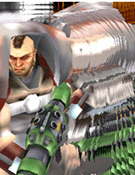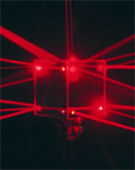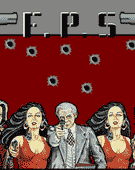Playas: Homeland Mirage is an interactive installation and video game that conflates issues of security within the context of suburbia and our recent obsession with terrorism. A person sits at the console and plays a video game, in which the goals are to stay alive and explore a simulation of Playas, New Mexico, USA. The presence of others within the installation space transforms the game image into a mirage, which is projected into the exhibition environment. Virtual game characters include innocents, terrorists, and Department of Homeland InSecurity (DHI) agents. Playas was a company railroad town, established in the early 1900s. It was abandoned and then reconstructed as a suburban mining town in the seventies. Abandoned again in 1999, Playas was purchased in 2004 as the site of a training facility for the U.S. Department of Homeland Security. As the player explores each home in the Playas construct, historical photographs from ...
Full Description
Playas: Homeland Mirage is an interactive installation and video game that conflates issues of security within the context of suburbia and our recent obsession with terrorism. A person sits at the console and plays a video game, in which the goals are to stay alive and explore a simulation of Playas, New Mexico, USA. The presence of others within the installation space transforms the game image into a mirage, which is projected into the exhibition environment. Virtual game characters include innocents, terrorists, and Department of Homeland InSecurity (DHI) agents. Playas was a company railroad town, established in the early 1900s. It was abandoned and then reconstructed as a suburban mining town in the seventies. Abandoned again in 1999, Playas was purchased in 2004 as the site of a training facility for the U.S. Department of Homeland Security. As the player explores each home in the Playas construct, historical photographs from the site are displayed. Environmental background information and imagined family scenarios are available on demand. Objects left behind in the abandoned homes trigger video imagery that questions our responsibilities and place in the world. Meanwhile, as other human participants enter the installation zone, a video tracking system monitors them and spawns a new virtual character for each. Innocents and terrorists are visually similar, appearing as civilians, while DHI agents wear SWAT uniforms. DHI agents hunt terrorists, but periodically kill innocents, including the game player. For every innocent they kill, multiple new terrorists are spawned. The exploring game player can hardly distinguish each approaching character as friend or threat. One character may simply want water, while another may self-detonate. A third may suspect you are a terrorist, and shoot. Tension between the curiosity for exploration and the fear of threats provides conflict within the game. In addition to the spawning of characters in-game, the presence of human participants also impacts the visual representation of the environment. This is an intentional act to suggest the idea that we, as a society, are implicit in the world we create. As viewers move throughout the installation space, a ghost-like form of their presence is blended with the game environment. Their presence transforms the video imagery into the form of a mirage.
This set of circumstances and the geography of this place raise questions about constructed realities. How real is the training that will take place in these environments? What is the primary threat, and is it real? What parallels exist between our response to urbanism (suburbia) and our response to domestic terrorism?
Work metadata
- Year Created: 2005
- Submitted to ArtBase: Friday Dec 30th, 2005
- Original Url: http://playas.homelandmirage.net/
- Permalink: http://playas.homelandmirage.net/
-
Work Credits:
- Jack Stenner, creator
Take full advantage of the ArtBase by Becoming a Member





